Chances missed to stop two recent US mass shootings
By MAY ZHOU in Houston | China Daily Global | Updated: 2022-07-13 10:12

The Texas elementary school mass shooting and the Fourth of July parade shooting in Illinois potentially could have been prevented if proper actions were taken, according to reviews of both deadly attacks.
Police had missed more than one opportunity to stop the 18-year-old gunman who on May 24 opened fire at Robb Elementary School in Uvalde, Texas, killing 19 schoolchildren and two teachers, the report from an investigation by the Advanced Law Enforcement Rapid Response Training Center shows.
At the start of the shooting, a school district police officer first arriving at the scene drove through the parking lot on the west side of the school building at a high speed while the suspect was in the parking lot. The officer failed to see him.
"If the officer had driven more slowly or had parked his car at the edge of the school property and approached on foot, he might have seen the suspect and been able to engage him before the suspect entered the building," the report said.
Another responding Uvalde police officer spotted the suspect carrying a rifle outside the west hall entry before he entered the school.
"The officer, armed with a rifle, asked his supervisor for permission to shoot the suspect. However, the supervisor either did not hear or responded too late," the report said.
When the officer turned back to address the suspect, he had entered the west hallway.
"A reasonable officer would conclude in this case, based upon the totality of the circumstances, that use of deadly force was warranted," the report said.
The suspect entered the school at 11:33 am. Within three minutes, he fired more than 100 rounds into two classrooms.
The report said the situation became static from 11:38 am when more than 10 responding police officers gathered in a hallway outside of the two classrooms held by the suspect.
The officers called for backup, and more officers from various branches arrived at the scene by 11:52 am with helmets and bulletproof vests. However, no action was taken until 12:50 pm.
The report said that in an active shooting situation, it is imperative that an immediate action plan is created while waiting for backup.
"It appears that the officers did not create an immediate action plan," the report said.
The report pointed out that the first responders' main priority in an active shooter situation is to first "Stop the Killing" and then "Stop the Dying".
There were numerous points in time when the police officers on the scene should have acted because the gunman was firing, and the officers knew the injured need urgent care.
"While we do not have definitive information at this point, it is possible that some of the people who died during this event could have been saved if they had received more rapid medical care," the report said.
The report also said that effective incident command wasn't established during the incident. "The lack of effective command likely impaired both the Stop the Killing and Stop the Dying parts of the response," it said.
Another factor was a missed opportunity to breach the classrooms. The officers on the scene asked for a master key to open the doors, but later examination indicated they weren't locked because they can only be locked from outside with a key. The report said that "it does not appear that any officer ever tested the doors to see if they were locked".
Peter Arredondo, the chief of the Uvalde Consolidated Independent School District Police Department, who has drawn criticism over the law enforcement response to the Uvalde shooting, has defended himself in interviews.
He has said that the officers tried the doors and found them locked, contradictory to the report. Arredondo said that he then focused his efforts on finding a master key that would open the doors, a process that took more than 40 minutes.
In the July 4 parade shooting in Highland Park, Illinois, the suspect, Robert Crimo, could have been prevented from legally purchasing the firearms he used to kill seven people if a "red flag" law were properly followed.
Crimo is from a troubled family. Records showed that police visited the family nearly 20 times between 2009 and 2014 due to conflicts between Crimo's parents. Nine calls were about domestic violence, but no arrest was ever made.
In April 2019, police were called for a wellness check on Crimo. He threatened to kill himself with a machete, and police were told he was seen by mental health professionals a week prior.
Five months later, in September 2019, police were called again after a family member claimed that Crimo was threatening to "kill everyone" in the house. A samurai sword, a dagger and 16 knives were removed from the home.
Crimo told the police that he was depressed and had a history of drug use, but he had no intention to kill himself or others. He left his family to live with his uncle after that.
The incident led the Highland Park Police to file a report deeming Crimo as a "clear and present danger". The report was sent to the Illinois State Police (ISP).
Illinois has red flag laws to deny an unstable and dangerous person from getting a firearms-purchasing license.
However, when Crimo applied for a license with his father's endorsement three months following the last incident, ISP ultimately dismissed the alert and granted him the license.
The state said its review found the alleged threat was reported "second-hand" to officers, and Crimo and his mother disputed that a threat had occurred, and that his father claimed ownership of the bladed weapons.
Crimo also posted threatening messages and violent images on social media. However, that escaped the notice of police who lack the staff to do a thorough check on every applicant.
























